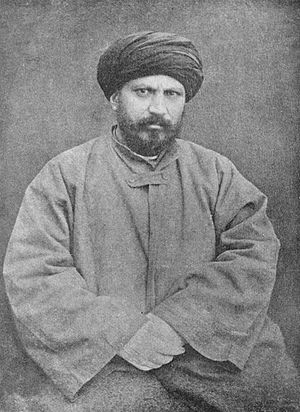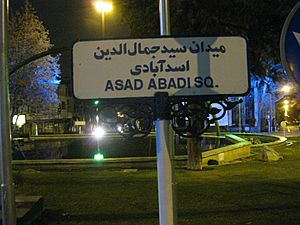Jamal al-Din al-Afghani facts for kids
Quick facts for kids Sayyid Jamāl al-Dīn Afghānīسید جمالالدین افغانی |
|
|---|---|
 |
|
| Religion | Islam |
| Personal | |
| Nationality | Disputed |
| Born | Sayyid Jamaluddin ibn Safdar 1839 Kunar, Afghanistan or Hamadan, Iran |
| Died | 9 March 1897 (aged 58) Istanbul, Ottoman Empire |
| Cause of death | Cancer of the jaw |
| Resting place | Kabul, Afghanistan |
| Influenced | Muhammad Abduh, Rashid Rida, Maulana Azad, Saad Zaghloul, Mirza Reza Kermani |
Sayyid Jamāl al-Dīn al-Afghānī (born 1838 or 1839 – died 9 March 1897), often called Al-Afghani, was an important political thinker and activist. He traveled across the Muslim world in the late 1800s.
He helped start a movement called Islamic Modernism. He also strongly supported Pan-Islamism, which means uniting all Muslim people. In India, he believed that Hindus and Muslims should work together against the British. He wanted Muslims to be strong and united against outside pressures.
Al-Afghani was also involved in the plot to assassinate Shah Naser-al-Din of Iran. He felt the Shah was giving too many benefits to foreign powers, especially the British.
Contents
Early Life and Background
Al-Afghani claimed he was from Afghanistan. His full name, al-Afghani, means "the Afghan." However, where he was truly born and his family background are debated.
One idea is that he was born in Asadābād, near Kabul, in Afghanistan. This is what he often said.
Another idea, supported by some scholars, is that he was born in a Shia family in Asadabad, near Hamadan, in Iran. People who believe this think he claimed Afghan roots to gain influence among Sunni Muslims or to avoid problems with the Iranian ruler.
He was educated at home first. Then, his father took him to cities like Qazvin, Tehran, and later to important Shia cities in what is now Iraq. He used other names too, like al-Kābulī (meaning "from Kabul") and ar-Rūmī (meaning "the Roman" or "the Anatolian").
Political Journey
When he was about 17 or 18, around 1856, Al-Afghani traveled to British India. He spent several years there studying different religions.
In 1859, a British spy thought Al-Afghani might be a Russian agent. British officials reported that he spoke Persian, Arabic, and Turkish fluently.
After his first trip to India, he went on the Hajj, a pilgrimage to Mecca. He arrived in Tehran in late 1865 and then left for Afghanistan in the spring of 1866.
In Afghanistan
Al-Afghani was seen in Afghanistan in 1866. He spent time in Qandahar, Ghazni, and Kabul. Reports said he was new to Afghanistan and spoke Persian with an Iranian accent. He seemed to follow a European lifestyle more than a Muslim one, not always observing Ramadan.
He became an advisor to Mohammad Afzal Khan, the son of the former ruler. Al-Afghani encouraged him to seek support from Russia instead of the British. In 1868, Mohammad Afzal's half-brother, Sher Ali Khan, won the civil war and forced Al-Afghani to leave the country.
Travels and Activism
After leaving Afghanistan, Al-Afghani traveled through India and Cairo on his way to Constantinople (modern-day Istanbul). In Cairo, he met a young student named Muhammad 'Abduh, who became his devoted follower.
In Constantinople, he met with important officials and got a job on the Council of Education. He gave a speech at the opening of Istanbul University, sharing his modern ideas. However, some religious leaders found his views too extreme. The university closed in 1871, and Al-Afghani was expelled.
He then moved to Egypt and started sharing his ideas for political change. The Egyptian government initially supported him. But because he openly criticized France and England, he was sent to India in 1879. He stayed there for a while before traveling to many European cities, including London, Paris, Moscow, and Munich.
Freemasonry and Politics
While in Egypt, Al-Afghani wanted to remove the ruler, Khedive Ismail, who he saw as too friendly with the British. He used Freemasonry, a social organization, to help his political activities. He saw Freemasonry as a way to promote his anti-colonial and pan-Islamic goals.
His political actions played a big part in Khedive Ismail being removed and Tawfiq Pasha becoming the new ruler. However, local Masons were not interested in politics and wanted to get along with the British. Around 1875, Al-Afghani left Freemasonry because he realized they were not helping his anti-British goals.
Newspaper and Return to Iran
In 1884, he started an Arabic newspaper in Paris called al-Urwah al-Wuthqa ("The Indissoluble Link") with Muhammad Abduh. The newspaper urged Muslims to return to the original ideas of Islam and to unite. He believed this unity would help the Islamic community regain its strength against European powers.
In 1886, Al-Afghani visited Bushehr in southern Iran. He was invited to Tehran by Shah Nasser ad-Din's minister. But he quickly lost the Shah's favor. The Shah asked for him to be sent to Russia, where Al-Afghani stayed from 1887 to 1889.
From Russia, he traveled to Munich and then returned to Iran in late 1889. Because of his political activities, the Shah planned to expel him again. Al-Afghani found out and sought safety in a holy shrine near Tehran. After seven months of speaking to his supporters from the shrine, he was arrested in 1891. He was then taken to the border and forced to leave Iran.
Al-Afghani strongly disliked the Shah, accusing him of weakening Islam by giving too many benefits to Europeans and wasting money. His actions against the Shah helped spark the successful Tobacco Protest in 1891, which opposed a British company getting a monopoly on tobacco. His ideas also influenced the later Iranian Constitutional Revolution in 1905.
Final Years and Assassination Plot
After leaving Iraq, he went to England in 1891 and 1892. Later, in 1892, he was invited to Istanbul by a member of Sultan Abdulhamid II's court. He traveled with diplomatic protection from the British, which surprised many. The Sultan gave him a house and a salary, hoping to use Al-Afghani to promote Pan-Islamism.
While in Istanbul in 1895, Al-Afghani was visited by Mirza Reza Kermani, a former prisoner and follower. Together, they planned to assassinate the Shah, Naser-al-Din. They also worked with Mirza Malkam Khan, a former Iranian official, to attack the Shah's rule in a London newspaper.
Kermani later returned to Iran and assassinated Naser-al-Din with a gun on May 1, 1896. This happened while the Shah was visiting the same shrine where Al-Afghani had once sought refuge. Kermani was executed in August 1897. The Iranian government tried to get Al-Afghani sent back from Turkey, but they were not successful. Al-Afghani himself died of cancer that same year.
Ideas and Beliefs
Al-Afghani's ideas combined traditional religious dislike for non-Muslims with a modern criticism of Western imperialism. He called for the unity of Islam and urged Muslims to adopt Western science and systems that could make Islam stronger.
His friend, the British poet Wilfrid Scawen Blunt, saw him as a liberal. In some of his writings, Al-Afghani compared the parliamentary system to the shura (consultation) system mentioned in the Qur'an. However, he was unsure if constitutional government would work well in the Islamic world. His goal was to remove weak rulers who served foreigners and replace them with strong, patriotic leaders.
Al-Afghani was very disappointed by the failure of the Indian Mutiny. From this, he concluded three main things:
- European powers, after conquering India, were now threatening the Middle East.
- Asia, including the Middle East, could only stop Western powers by quickly adopting modern technology, just like the West.
- Islam, despite its traditions, was a powerful belief system for uniting people against foreign invaders.
He believed that Hindus and Muslims should work together to end British rule in India. This idea was later supported by Maulana Syed Husain Ahmad Madani decades later.
Al-Afghani thought that Islam and its laws could work well with reason and logic. He believed that Muslims could unite politically while keeping their faith, which was based on religious and social morals. These ideas greatly influenced Muhammad Abduh, who further developed the idea of using reason in the human aspects of Islam.
In 1881, he published a book called Al-Radd 'ala al-Dahriyyi (Refutation of the Materialists). In it, he argued for pan-Islamic unity against Western imperialism. This book included one of the first Islamic arguments against Darwin's On the Origin of Species. However, his arguments were criticized for not accurately representing Darwin's ideas. In a later work, Khatirat Jamal ad-Din al-Afghani, he accepted the idea of evolution. He said that the Islamic world already knew about it. While he accepted the evolution of animals, he did not believe that humans evolved from animals, arguing that humans have souls.
Al-Afghani was very interested in political unity between Shia and Sunni Muslims. However, he didn't focus much on finding common religious ground between them. For example, when he moved to Istanbul, he hid his Shi'i background by calling himself "the Afghan."
Death and Legacy

Al-Afghani died of jaw cancer on March 9, 1897, in Istanbul and was buried there. In late 1944, the Afghan government asked for his remains to be moved to Afghanistan. His funeral was held in Peshawar's Qissa Khwani Bazaar. Afterward, his remains were buried in Kabul at Kabul University. A special building was built there to honor him.
In October 2002, the American Ambassador to Afghanistan, Robert Finn, promised $25,000 to fix the building, which had been damaged during the civil war. The repairs were finished in 2010.
Many places are named after him. In Kabul, Afghanistan, there is a university called Syed Jamaluddin Afghan University and a street named Afghani. In other parts of Afghanistan, there are hospitals, schools, and parks named after him.
In Peshawar, Pakistan, there is also a road named after him.
In Tehran, the capital of Iran, there is a square and a street named after him (Asad Abadi Square and "Asad Abadi Avenue").
Works
- "Sayyid Jamāl-ad-Dīn al-Afghānī:", Continued the statement in the history of Afghans Egypt, original in Arabic: تتمة البيان في تاريخ الأفغان Tatimmat al-bayan fi tarikh al-Afghan, 1901
- Sayyid Jamāl-ad-Dīn al-Afghānī: Brochure about Naturalism or materialism, original in Dari language: رساله نیچریه (Ressalah e Natscheria) translated by Muhammad Abduh into Arabic.
See also
 In Spanish: Jamal al-Din al-Afghani para niños
In Spanish: Jamal al-Din al-Afghani para niños
- Tobacco Protest
- Muhammad Bakhit al-Muti'i
- Mustafa Sabri

